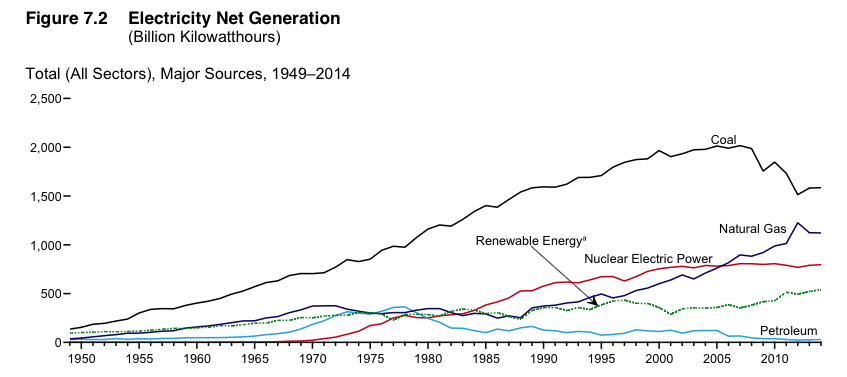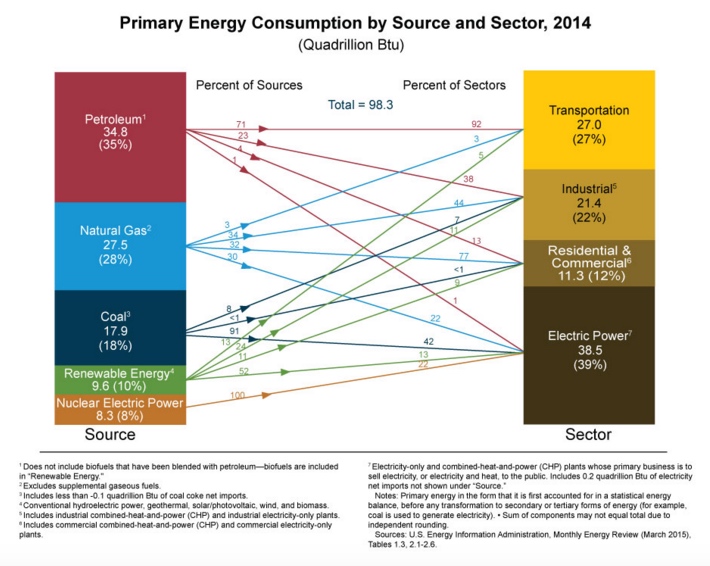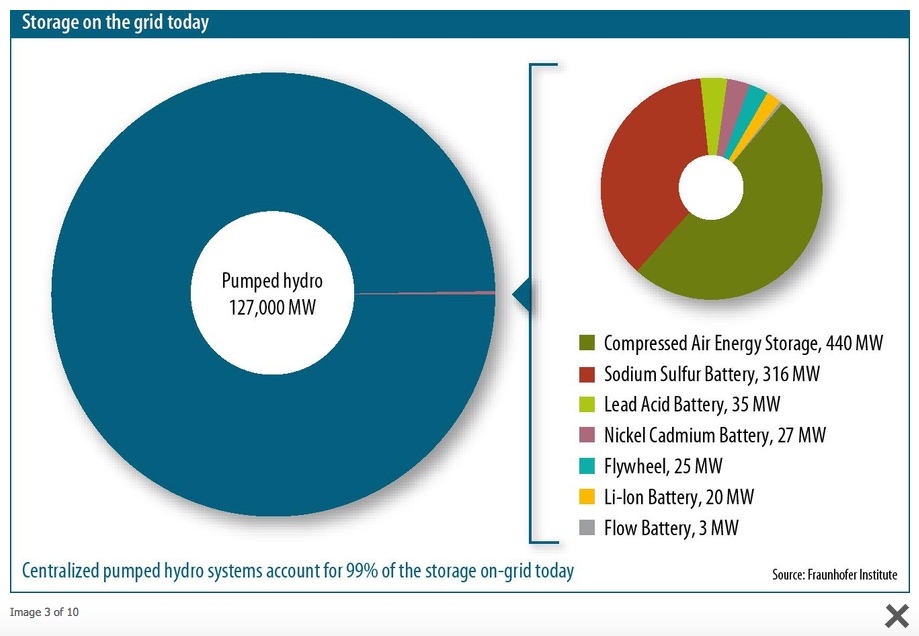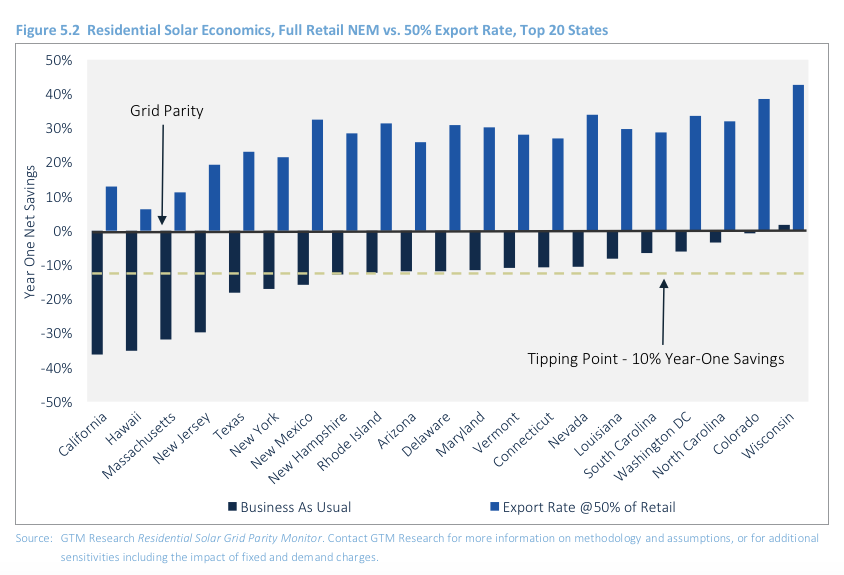About 1% of Solar energy produced today is stored in batteries.
Obviously, Solar energy does not produce when the Sun goes down, and we use a lot of energy when the Sun goes down. I do not have figures for how much energy we use in the daytime vs. the nighttime, but let's assume it's roughly a 50/50 split.
Assuming Solar energy can account for all of our daytime needs, we'll still need something producing that other 50%.
It's a little more interesting than that because, today, 50% of Solar energy is produced on Residential/Commercial buildings. Most Residential does not use that electricity during the day, since most of us are at an office. Where does that electricity go?
It goes to The Grid.
The majority of Residential Solar electricity is sold to the Grid during the day, and then the Solar homeowner buys his/her electricity back from the Grid at night. In this way, the Grid is not only the source of that other 50%, it's also one Gi-Normous battery for Solar energy produced during the day that is not readily consumable. (Note: Utilities are starting to change their Net Energy Metering agreements to reduce the amount they pay for Residential Solar energy - effectively charging for the use of the Grid battery
- and changing the payback formula for the Solar homeowner.)
The charts below remind us of what makes up the Grid today.


These are all the CO2 sources we want to eliminate. Without batteries, we'll still need 50% of these sources.
Notice the Transportation portion of our overall needs in the 2nd chart. We could potentially use Solar energy to power electric cars during the day (while we sit in the office).
Batteries [1]
The Grid would not be needed if we had enough battery power to store all the Solar produced during the day.
Where are we with Solar energy batteries? Unfortunately, we are very early days. Utilities are starting to add storage to address their own Solar (and Wind) energy growth as well as the growth from Residential and Commercial Solar. Tesla has also recently made waves with announcements for Residential Solar batteries.
The chart below shows the storage options Utilities have today.

According to a recent study (Frost & Sullivan), there is about 430 MW of Battery Energy Storage System (BESS) in the world today. They expect this to grow to 12 GW of BESS by 2024 (worldwide), and they say this will be led by lithium ion (Li-on) technology.
Let's take a closer look at the Tesla battery options. Tesla is also using Lithium ion batteries. Lithium ion batteries probably deserve their own section, but let's move on.
| Tesla POWERWALL Battery Costs for our 4kW Example[2] |
|---|
| We use 6,218 kWh/Year or 17 kWh/Day |
| Tesla sells a 7 kWh System. We'll assume this is big enough. |
| Telsa sells to Installers for $3,000. We'll assume $4,000 Retail. |
| Tesla 7 kWh POWERWALL discharges 28,980 kWh over its 10 year lifetime. |
| 6,218 kWh * .50 = 3,109 kWh/Year |
| We'll assume we need to charge 50% of our electricity. |
| 28,980 kWh / 3,109 kWh = 9.32 Years |
| Conclusion: We'll need to buy 2 Tesla POWERWALL 7 kWh systems over the lifetime of our Solar system, or $8,000 added cost. |
The following Chart shows the added battery costs for our 4 kW system example from the Solar Economics section. We are being conservative by saying we only need 2 batteries. We'd really need 3 to get us to the 25 year lifetime of our system. A 7 kWh battery might not be enough, and $4,000 might be too low.
| 4 kW Solar System Including Batteries | ||||
|---|---|---|---|---|
| T | Generated Value | Costs | Payback | Profit |
| With ITC: | $969 | $13,200 | 13.6 Years | $11,045 |
| With ITC and Batteries: | $969 | $21,200 | 21.9 Years | $3,004 |
| Without ITC: | $969 | $18,000 | 18.6 Years | $6,201 |
| Without ITC and With Batteries: | $969 | $26,000 | 26.8 Years | $0 |
Costs still don't look terribly out of control, but we do not have much data yet since only 1% of Solar is battery stored today. We'll have to wait and see. However, a 14-year payback vs. a 22-year payback does raise the bar for Solar (Do I remodel the kitchen or install Solar?).
Batteries pose another challenge in that we have to account for the Second Law of Thermodynamics again. A quick check on the Tesla support blog estimates the loss at about 20%. Therefore, we pay a 20% penalty for storing Solar energy as opposed to using it as it is generated (Charging our cars during the day would be one way to save this 20%.).
In summary, it looks like we'll still need The Grid until we've built out the battery infrastructure. It's hard to say at this point how long that will take, but we are starting at 1%, so it will probably be a while.
In the next section, we'll look at what it would take to scale Solar energy to meet all of our energy needs.
